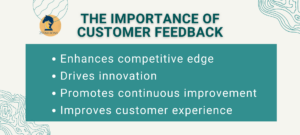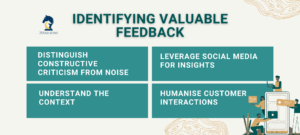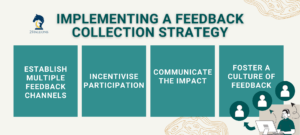Content
SHARE

In today’s competitive marketplace, customer feedback is crucial for brand offerings. By listening to customers, brands can gain valuable insights that help them improve their products, services, and overall customer experience. In this article, we will explore the importance of customer feedback and discuss practical steps that can be taken to harness this valuable resource and make informed decisions.

Understanding the importance of customer feedback
Customer feedback serves as a compass for brand development. It provides brands with a deep understanding of their customers’ needs, preferences, and pain points. By actively listening to what customers say, brands can align their offerings with customer expectations, ultimately enhancing their competitive edge.
Moreover, customer feedback can serve as a source of inspiration for innovation. Ideas and suggestions from customers provide brands with fresh perspectives and help them identify untapped opportunities in the market.
When brands delve into customer feedback, they embark on a journey of discovery and improvement. Each piece of feedback is a valuable nugget of information that can guide brands towards success. By carefully analysing and acting upon customer feedback, brands demonstrate their commitment to continuous growth and customer satisfaction.
The Role of Feedback in Brand Development
Customer feedback is a critical component of the brand development process. It enables brands to fine-tune their positioning, messaging, and overall brand identity. By incorporating customer feedback into their branding efforts, brands can create a stronger emotional connection with their target audience and gain loyalty.
Furthermore, customer feedback can act as a litmus test for brand authenticity. When brands listen to their customers and adapt based on their feedback, they willingly evolve and meet the ever-changing market demands. This adaptability enhances brand perception and fosters a sense of trust and credibility among customers.
How Feedback Shapes The Customer Experience
Customer experience is at the heart of every successful brand. By collecting customer feedback, brands can identify pain points in their journey and make the necessary improvements. This iterative process allows brands to provide seamless experiences that exceed customer expectations and foster long-term relationships.
Moreover, customer feedback plays a pivotal role in shaping brand reputation. Positive feedback can be a powerful endorsement, attracting new customers and solidifying brand loyalty. Conversely, negative feedback lets brands showcase their dedication to customer satisfaction by addressing issues promptly and effectively.
Identifying valuable feedback
Not all feedback is created equal. While collecting feedback is important, brands must also focus on distinguishing valuable insights from noise. By considering the following factors, brands can identify feedback that truly matters:
Distinguishing Constructive Criticism from Noise
Constructive criticism is feedback that provides specific suggestions for improvement. Brands should pay close attention to this type of feedback as it offers actionable insights. On the other hand, noise refers to irrelevant or baseless comments that do not contribute to meaningful change. Brands should filter out noise and focus on feedback that can drive positive outcomes.
Moreover, brands need to understand the context in which feedback is given. Sometimes, what may initially seem like noise could hold valuable insights when viewed in the right light. Taking the time to analyse and interpret feedback comprehensively can lead to hidden gems that may have been initially overlooked.
Utilising Social Media for Customer Insights
Social media platforms have become hubs for customer feedback. Brands can leverage these platforms to gain real-time insights into customer sentiment and preferences. By monitoring social media conversations, brands can identify trends, engage in dialogue with customers, and act swiftly to address their concerns.
Furthermore, social media provides a unique opportunity for brands to humanise their customer interactions. By responding promptly and authentically to feedback on social platforms, brands can build trust and loyalty among their audience. This personalised approach can set brands apart in a crowded digital landscape, fostering stronger customer connections and enhancing brand reputation.
Implementing a Feedback Collection Strategy
Collecting feedback is not a one-time activity but an ongoing process. To ensure customer feedback becomes ingrained in the brand’s decision-making process, brands must establish a feedback collection strategy.
Feedback is vital for businesses to understand their customers better and improve their products and services. It provides valuable insights that can drive innovation and enhance customer satisfaction. Therefore, implementing a robust feedback collection strategy is crucial for long-term success.
Setting Up Feedback Channels
Offering multiple feedback channels is key to capturing diverse customer perspectives. Brands can implement online surveys, feedback forms on their website, email feedback requests, and even customer helplines to gather feedback. By providing various channels, brands make it easier for customers to share their thoughts and opinions.
Each feedback channel serves a unique purpose and caters to different customer preferences. Online surveys are convenient for gathering structured feedback, while website feedback forms allow for detailed comments. Email feedback requests provide a personal touch, and customer helplines offer immediate assistance for customers who prefer verbal communication.
Encouraging Customer Participation in Feedback
Brands should actively encourage customers to share their feedback. By incentivising participation, such as offering discounts or rewards, brands can increase the quantity and quality of the feedback collected. Moreover, brands should communicate the impact of customer feedback, making customers feel valued and motivated to contribute.
Customer participation in feedback benefits the brand and enhances the overall customer experience. Customers who see that their feedback leads to tangible improvements tend to engage with the brand and become loyal advocates. Therefore, fostering a culture of feedback participation is essential for building strong customer relationships and driving business growth.
Analysing and interpreting customer feedback
Collecting feedback is the first step; the real value lies in analysing and interpreting the data gathered. By doing so, brands can extract actionable insights and make data-driven decisions.
Understanding customer feedback is a crucial aspect of any successful business strategy. It provides valuable insights into customer satisfaction, preferences, and pain points. By delving deep into the feedback received, brands can uncover hidden opportunities for growth and innovation.
Turning Feedback into Actionable Insights
Brands should organise and categorise feedback to identify patterns and trends. By clustering similar feedback, brands can prioritise the areas that require attention. These insights can then be used to develop strategies for addressing customer concerns and implementing improvements.
Analysing feedback also enables brands to identify recurring issues impacting customer loyalty. By addressing these issues promptly, brands can enhance customer satisfaction and loyalty, leading to increased retention rates and positive word-of-mouth.
Monitoring Feedback Trends Over Time
Customer preferences and expectations evolve. Brands should track feedback trends to stay abreast of changes in customer sentiment. By consistently monitoring feedback, brands demonstrate their commitment to continuously improving and adapting to the ever-changing needs of their customers.
Tracking feedback trends over time also allows brands to measure the effectiveness of their initiatives and improvements. By comparing feedback data from different periods, brands can gauge the impact of their actions and make informed decisions on future strategies.
Making improvements based on feedback
Collecting feedback is the first step; the real value lies in analysing and interpreting the data gathered. By doing so, brands can extract actionable insights and make data-driven decisions.
Understanding customer feedback is a crucial aspect of any successful business strategy. It provides valuable insights into customer satisfaction, preferences, and pain points. By delving deep into the feedback received, brands can uncover hidden opportunities for growth and innovation.
Prioritising Changes Based on Customer Input
Not all feedback requires immediate action. Brands should prioritise changes based on the severity of the problem and the influence it has on the overall customer experience. By focusing on the changes that will have the most significant impact, brands can allocate their resources effectively.
In addition to prioritising changes, brands should consider the long-term implications of each improvement. It is crucial to assess how each change aligns with the brand’s values and long-term goals to ensure consistency and sustainability in the customer experience.
Communicating Changes to Customers
When implementing changes based on customer feedback, brands should communicate these changes to their customers. By actively sharing updates and improvements, brands show that they value their customers’ opinions and that their feedback has been heard and acted upon. This transparent communication fosters trust and ultimately strengthens the customer-brand bond.
Moreover, effective communication of changes can also engage customers in the brand’s evolution. By involving customers in the improvement process, brands can create a sense of ownership and loyalty among their customer base, leading to increased brand advocacy and customer retention.
In conclusion, customer feedback is a valuable resource that can drive the success of a brand. By understanding the importance of customer feedback, identifying valuable insights, implementing a feedback collection strategy, analysing and interpreting feedback, and making improvements based on customer input, brands can harness the power of feedback to improve their brand offerings and create exceptional customer experiences.
Frequently Asked Questions About Harnessing Feedback: Practical Steps to Improve Brand Offerings Based on Customer Input
Why is customer feedback crucial for improving brand offerings?
Customer feedback is crucial as it provides direct insights into customer experiences, expectations, and pain points, allowing brands to tailor and enhance their products and services effectively to meet user needs.
What are the practical steps to harness customer feedback?
Practical steps include actively soliciting feedback through surveys and focus groups, analysing the data to identify common themes, implementing changes based on insights, and continuously monitoring the impact of those changes on customer satisfaction.
How can brands effectively collect customer feedback?
Brands can effectively collect feedback by utilising multiple channels such as online surveys, social media interactions, customer support interactions, and in-person events to ensure a broad and diverse range of inputs.
What should brands do after collecting customer feedback?
After collecting feedback, brands should categorise and analyse the data to determine actionable insights, develop a strategic plan to address feedback, implement changes, and communicate these changes back to customers to show responsiveness and enhance trust.
















